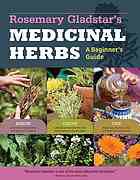Rosemary Gladstar’s Medicinal Herbs : A Beginner’s Guide. / Rosemary Gladstar, 2012. Storey Publishing, 2013. 224 pages; illustrations in color; index.

Eating your medicine from kitchen herbs is just part of the story. Just knowing the range of possibilities with herbs, that their table use expands to the medicinal (headaches, cuts, colds, and longevity) is inspiration for taking cues from this book.
Now in its fifth year of providing valuable information on herbal medicines, Rosemary Gladstar’s Medicinal Herbs : A Beginner’s Guide, is the perfect handbook of remedies for home use. Both attractive and practical, the book is geared towards the budding herbalist, someone who wants to learn how to prepare herbs to stock in their pantry and medicine cabinets. Yet anyone with an interest in maintaining good health and providing relief for chronic or acute conditions will benefit from Gladstar’s guide. Two of the chapters focus on subsets of herbs: those from your kitchen cupboard—9 herbs and spices—and the author’s pick of 24 medicinal herbs not normally found as food. Separate sections tutor a reader in the art and science of making tinctures, salves, teas and oils, even beauty products, that by their 100% wholesomeness and freshness will be among the best health remedies available to readers, especially if you factor in price.
Her books are always very easy to follow, with interesting text illustrated by photographs of herbs and the processes of preparing them. In this book there are descriptions of over 30 easily grown and prepared herbs, alphabetically arranged from Basil to Turmeric and Aloe Vera to Yarrow. Gladstar’s love of nature and of the power of herbs to lift us out of many acute and chronic conditions is unmistakable, given with a good measure of personalized advice.
In Gladstar’s Medicinal Herbs a reader feels drawn into the herbalist’s circle because the recipes are so fluid and simple, yet skillfully written for typical problems: colds, fever, skin issues, stress and energy, detox and liver issues, headaches, immunity, eye infections, SAD (seasonal affective disorder), digestive issues, endocrine, prostate and bone health, sleep—and more not detailed here.
A sample entry is of general interest to cooks: seasoned salads or pesto made with the herb Basil. It might be a table favorite at your house. In other roles for the herb, Basil with Lemon Balm and Lavender are mixed together in a tea for stress. For someone suffering from a sluggish liver, for example, Gladstar shows you how to make medicinal pesto with herbs like dandelion greens, with suggestions for more combinations with wild herbs like Nettle or Plantain and culinary herbs like Mint, Oregano and Thyme. And she adds tips for storage, as in freezing the pesto in ice cube trays for future seasonings, especially if time is of the essence in your day.
A handful of herbs profiled in the book have a well-known culinary association recognized by most cooks who like to use herbs as agents of flavor. Enlarging that view to include medicinal herbs, there are some pleasant-tasting, and some rather medicinal-tasting that for many reasons are not considered culinary as well. Among Rosemary Gladstar’s favorites are herbal tinctures and herbal teas. In her handbook, medicinal herbs, barks, and berries often feature in chai, syrups, medicinal balls, and capsules and almost every herb has at least one recipe that should be ingested or taken in liquid for its benefits. In other words, taking herbs for your health is fun and flavorful and helps you to relax.
And, to show off the diversity of an herb’s benefits, recipes are suggested for topical application as well. These include liniments and salves or oils. To make an oil into a salve, you need to add beeswax to the herbed oil. It’s easy to do, and Rosemary Gladstar shows you how.
Gladstar’s Medicinal Herbs begins with instructions for concocting herbal remedies, as well as growing and harvesting them, given the space and time. Administering herbs to children, dosage guidelines, benefits and safety measures are all covered prior to sourcing herbs for your health questions.
See Rosemary Gladstar’s website Sage Mountain Herbs for more on herbs, courses and books.
Follow


